A Welcome By Dor
 I try really hard to keep my focus on real food and my values around locally sourced food and responsible practices. But I’ve climbed on board with a few fads – healthy fads – and felt like an idiot for going overboard on single ingredients. Do I have to worry about thallium in my kale? My doctor friend told me to stop eating flax seeds, and a girlfriend ended up in the emergency room when she ate too much chia seed without taking water.
I try really hard to keep my focus on real food and my values around locally sourced food and responsible practices. But I’ve climbed on board with a few fads – healthy fads – and felt like an idiot for going overboard on single ingredients. Do I have to worry about thallium in my kale? My doctor friend told me to stop eating flax seeds, and a girlfriend ended up in the emergency room when she ate too much chia seed without taking water.
It’s my body, right? So I’m doing it again. I’ve been reading so much about the brain benefits of coconut fat, I decided to try to get down a couple tablespoons per day. It’s not easy. It works best if I freeze it first and crack it up and use it like sprinkles. So me being me, I invented “brain chips”.
Having recently been contacted by a company that said I had to stop using the words “flavor bombs” for our flavor bombs because they had trademarked the phrase, I first went to the Internet to see if somebody already owned the words brain chips. I’m getting paranoid about words. So far it applies only to electronics not to food. So I took all my favorite ingredients that are supposed to be good for your brain, chopped them up, mixed them with coconut fat, and stuck them in the freezer. There’s a savory version for salads and a sweet version for dessert. You will definitely want to freeze them on sheets on parchment paper, it makes it a lot easier to crush it into chips and clean up afterwards.
Ingrid’s Story: This Is Not About Willpower
If the bariatric surgery office hadn’t made me wait for several months, I would have had part of my body removed. I was that desperate. I know people who think the surgery is heaven sent, and I am happy for them. Personally I think having a part of your body removed because you can’t stop eating is nutty, but I was about to do it myself because I was entirely enslaved to food and saw no other way out. Desperation is not a strong enough word to describe my situation. I’m so grateful a nutritionist steered me down another route.
This is not about willpower. Whatever my compulsion is, it operates on a plane beyond the reach of human willpower. Many a time I would wake up to find a mess of wrappers or dirty dishes in the kitchen, with only the vaguest recollection of going down in the middle of the night in a virtual trance, prowling around in the fridge. There were more conscious behaviors too, like when I’d order fast food and make noises about buying for the whole family, when it fact it was all for me. I would go home and eat until I was numb and hate myself afterward. I even passed up social invitations I might have enjoyed, fearing my friends would see me at my worst if I couldn’t control my eating at the buffet table.
I related these embarrassing experiences at a meeting with people I’d never met before. I was surprised to hear myself revealing humiliating secretes to total strangers. But as I spoke, I realized I had no telltale anxiety, no fidgeting, I was at ease. There is something about the culture of Suppers that makes it possible to walk into a meeting and start speaking my truth. “I never met you before but I feel safe already.” That sentence actually came out of my mouth — me, Ingrid, the closet everything. So many things clicked for me. After years of spending fortunes on diet programs that made me feel ashamed, this free alternative was making me feel peaceful and confident. I was doing my own experiments, not squishing myself into somebody else’s protocol. My eating decisions would be about what I need, not what they are selling. I got it: what I needed was real food, not pre-packaged, nutritionally calculated, scientific food-like matter. Food.
In the first few meetings, it was plain that the missing link for me was accepting that the foods I binged on were the ones I was addicted to. I would have to do experiments to determine which ones I could enjoy in moderation and which ones I’d have to avoid totally, at least for a while, because they triggered binge eating. And the antidote was not lectures, weigh-ins, or talking about my relationship with food. The antidote was cooking together, eating together, talking together, with the emphasis on “together.” For me this is as much about the people as it is about the food. When I arrive at a meeting, without fail, the second I walk in the door I feel the warmth of family Thanksgiving.
I’ve been assured that as my body does its housekeeping, my mood and emotions will become brighter and brighter. In a few short weeks I feel the difference already. I leaned over to the woman next to me and said, “So am I feeling more emotionally at ease because the food is healing me or because I found a community of nonjudgemental friends?” “Who cares?” she said. “As long as it works.”
Yeah, who cares. There’s something very complete and satisfying about preparing a meal with a bunch of people and sitting down to eat it. Who cares if I’m responding to protein, carbohydrates, and fat or support, acceptance, and love. When somebody takes the time to buy my food, teach me how to prepare it, and light a candle for my evening meal, I start feeling fed long before the first spoonful of soup goes down.
Brain Chips For Ingrid, By Allie
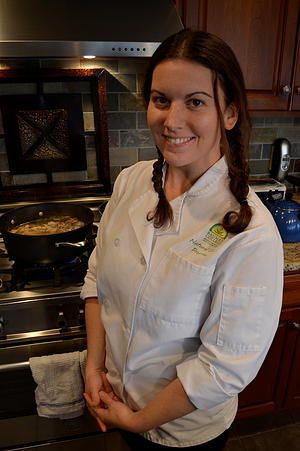 Food is satisfying and meals are nourishing. The difference is so key. We eat food when we are hungry, thirsty, or bored. We share meals with others or enjoy meals with ourselves when we are respecting the food and respecting ourselves.
Food is satisfying and meals are nourishing. The difference is so key. We eat food when we are hungry, thirsty, or bored. We share meals with others or enjoy meals with ourselves when we are respecting the food and respecting ourselves.
But let’s get real. We work. Even if we don’t have jobs, we Americans live fast paced, jam packed lifestyles with hardworking mentalities. Therefore we often complain about not having enough time to ourselves to relax OR to cook. Or to “cook”. Or to eat or “eat”. Those of us who have realized that the answer is a combination of cooking real food and sharing it with others are closer to vibrant health than anyone else. Of course, who doesn’t love a shortcut?
Brain Chips, Dor’s latest invention, are a perfect example of a homemade booster. I love boosters, personally. I love anything that is a small package full to bursting with nutrition. Mostly because I work.
I’ve also recently discovered that I love frozen nuts. Maybe it’s the heat. Dor always keeps her nuts and seeds in paper bags in her freezer and I know this because when I’m organizing things in her freezer to make room for or find something, I find the bag of nuts easily because of all the yummy fat seeping through the paper, telling me to have a snack. It’s literally the only way I enjoy cashew nuts by themselves – otherwise I think cashews are yucky. When they’re frozen they take on this beautiful sweet flavor and creamy texture. So Brain Chips combine whatever science is behind freezing nuts to bring out flavor (not sure if that’s a thing) and my number one favorite cooking fat: Coconut Oil.
Prized for its nourishing medium chain fatty acids, Coconut Oil is a bit of a rockstar these days when it comes to brain health studies. It also contains Lauric Acid, a fatty acid that is almost impossible to find naturally (although it is contained in breast milk). Its stability as a saturated fat makes it a good sauté oil but its smoke point isn’t crazy high (350). Still, it’s more difficult to oxidize Coconut Oil due to its natural hydrogen. Not to mention, its recent surge in popularity has made it more affordable and available. Coconut Oil is a perfect alternative ingredient to butter in baked goods like cookies, which require saturated fats to not melt all over the place in the oven. Finally, Coconut Oil is THE only oil that would work in Brain Chips because its flavor is unmatched. I don’t know anyone besides Homer Simpson (who I don’t actually know but I feel like I know him) who can take down even a bite of butter by itself and enjoy any bit of the experience. However, I can enjoy a bit of Coconut Oil on a spoon by itself without much suggestion.
That’s why Brain Chips are now a thing. Here’s how to make them. Do you have five minutes? Great.
Step One: Finely chop a bunch of walnuts (or almonds or any nut really but walnuts are shaped like brains and they’re good for your brain so use walnuts if you want to be relevant.)
Get all of the other ingredients you are using (lemon zest, grated ginger, spices, and 1/2 cup coconut oil today. And sea salt.)
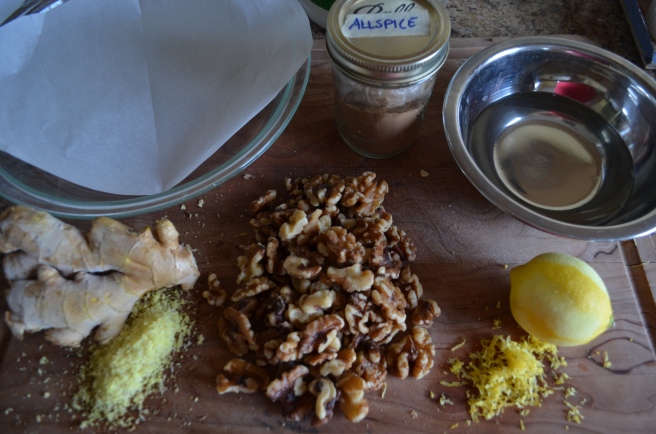
Step Two: In a parchment lined pie plate, arrange walnuts evenly and toss with all ingredients besides oil.
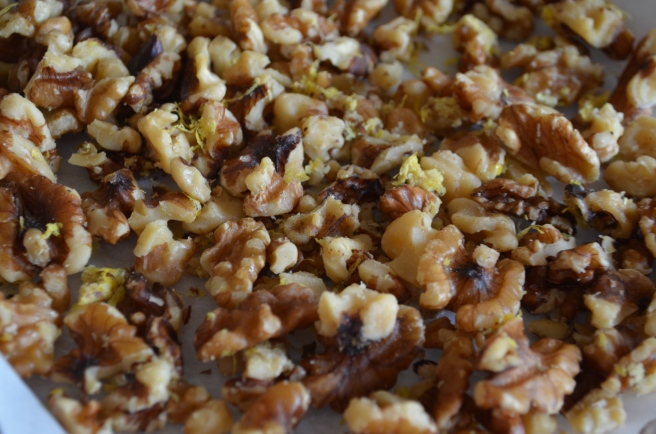
Step Three: Melt coconut oil and pour over walnut mixture. There should be a good layer of oil but it should not cover the mixture. It’s more like a bark. Except there’s no white chocolate. Also, can we please stop calling white chocolate “chocolate”? There’s nothing chocolatey about it.
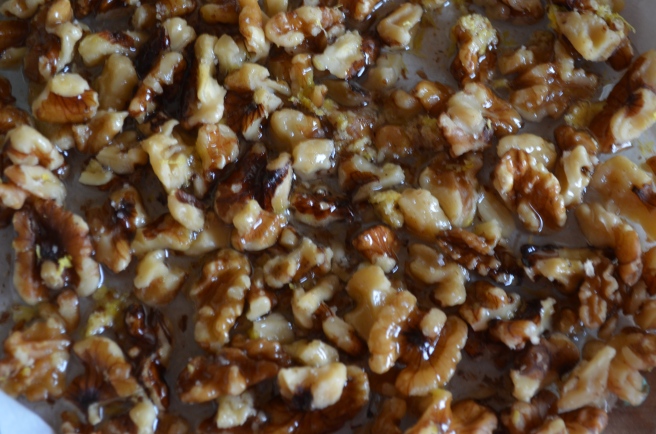
Step Four: Freeze for about 30 minutes at least. Then remove, break it up with a knife or smash it out of the pie plate and then smash up and down a few times on a clean cutting board. You’re done.
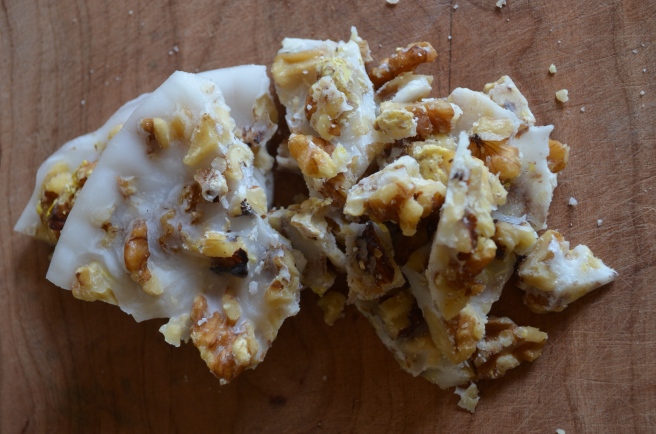
Sweet or Savory Brain Chips
For sweet:
1 cup walnuts, finely chopped
1/2 cup coconut oil, melted
pinch sea salt
*optional ingredients — choose up to 3 of the following:
1 Tablespoon cacao nibs
2 Tablespoons dried currants
2 Tablespoons shredded unsweetened coconut flakes
3 drops Stevia (drop into coconut oil to dissolve)
1 lemon, zested
1/2 teaspoon cinnamon, allspice, nutmeg, clove, ginger powder, etc.
1 teaspoon alcohol free vanilla
For savory:
1 cup walnuts, finely chopped
1/2 cup coconut oil, melted
pinch sea salt
*optional ingredient — choose up to 3 of the following:
1 teaspoon curry powder, chili powder, blackened seasoning, etc.
2 teaspoons freshly grated ginger
2 Tablespoons shredded unsweetened coconut flakes
1 Tablespoon pepitas or sunflower seeds
1. In a parchment lined glass 9-inch pie pan, arrange walnuts in an even layer. Add sweet or savory ingredients and stir together until evenly incorporated.
2. Pour coconut oil over mixture and, if necessary, use a spoon to coat walnuts and even out mixture.
3. Freeze at least 30 minutes and then remove. Chop with a knife or smash against a cutting board to break into pieces and store in a freezer. Enjoy sprinkled over chili, sorbet, grain salad, slaw, or your favorite dish!
Enjoy being extra brainy! For the month of August we are focusing on Social Support in The Purple Apron.
Suppers is a brain-based recovery program for preventing and reversing health problems with food. If you want to submit a story about how you achieved a clearer mind focusing on a diet of whole foods, please send in a story to Dor!
As always, head to our website for recipes, tips, stories, meeting schedules, registration for workshops, and more! The Suppers Programs is dedicated to helping YOU make your own personal transition towards a healthier life. Join us and discover your path towards vibrant health, seated next to a caring Suppers member, enjoying a divine meal together!
Suppers social resources:
Suppers Website
Facebook Page
Instagram handle @suppersprograms
